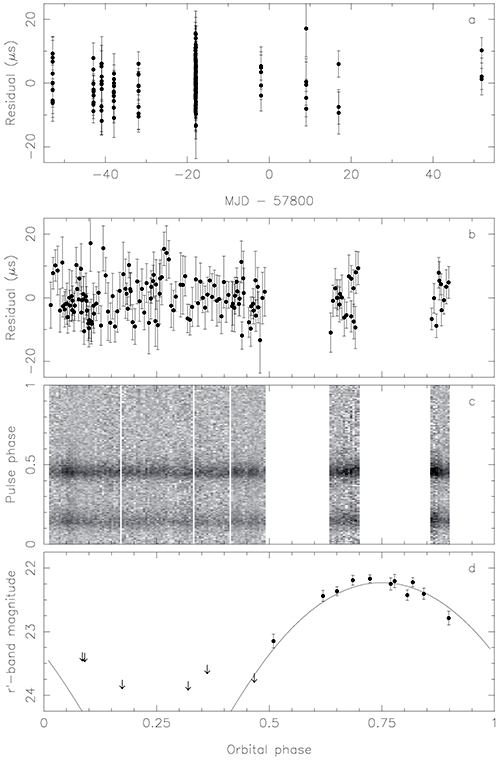ING web news release
25 September, 2017
The Fastest-Spinning Known Millisecond Pulsar in the Galactic Field
Using observations across the entire electro-magnetic spectrum,
astronomers have discovered a radio pulsar spinning 707 times every
second, making it the fastest known spinning pulsar in the Galactic field
and the second fastest known overall.
The pulsar emits pulsed electromagnetic radiation at very low radio frequencies and very high gamma-rays, while the low-mass binary companion, heated by the energetic radiation from the pulsar, is detected at optical wavelengths. The discovery of this system at
very low radio frequencies suggests there may be an as yet unseen
population of fast spinning radio pulsars.
The pulsar, PSR J0952-0607, was discovered with LOFAR, the
Low-Frequency Array, a radio telescope consisting of a dense core of antenna stations in the Netherlands, and international stations in
Germany, France, Sweden, the United Kingdom, Sweden, Poland and
Ireland. Operating at very low radio frequencies of 110 to 150 MHz,
the LOFAR telescope targeted unassociated high-energy gamma-ray
sources discovered with the space-based Fermi gamma-ray telescope,
searching for pulsed radio emission of radio and gamma-ray bright
millisecond pulsars.
Radio observations revealed that PSR J0952-0607 is part of a binary
system, where the pulsar orbits a very low mass (2% the mass of the
Sun) binary companion every 6.42 hours. In these so-called 'black widow'
systems, referencing the spider which consumes its mate, the
proximity of the companion to the pulsar meant the hemisphere facing
the pulsar is heated by the energetic pulsar emission, leading to the
evaporation of matter from the companion. This heating leads to large
variations in brightness of the companion over the course of an orbit.
|
 |
Timing residuals as a function of time and orbital phase are shown in panels (a) and (b) respectively. Folded pulse profiles of PSR J0952-0607 are shown as a function of orbital phase for the orbital phases covered by our observations (panel (c)). Eclipses of the radio signal in black widow systems occur around orbital phase φ=0.25 but are not obvious in PSR J0952-0607. Sloan r´-band light curve of the binary companion of PSR J0952-0607 (panel (d)). The Icarus model fit to the light curve is shown with the solid line.
Large format: PNG. |
"Optical observations with the Isaac Newton Telescope were
crucial in accurately pinpointing the location of the pulsar, since
both LOFAR and Fermi only provide localizations of a few arcminute
accuracy.", says Cees Bassa, lead author of the paper presenting the
discovery of PSR J0952-0607. Due to the large variation in optical
brightness, modulated at the orbital period of the binary, Bassa was
able to quickly identify the companion to PSR J0952-0607 in the time
series photometry, obtained with the Isaac Newton Telescope last
January in service mode.
The subarcsecond optical localization of the counterpart allowed the
astronomers to constrain the spindown rate of the millisecond pulsar,
which shows that it has a low magnetic field. Furthermore, modelling
the optical light curve reveals that the companion does not fill its
Roche lobe. The absence of occasional eclipses of the
radio emission is consistent with this, but is contrary to what's found in the majority of black widow systems.
The fast spin period of PSR J0952-0607 makes it a prime candidate for
further optical studies, as further modelling of the light curve in
multiple filters, combined with optical spectroscopy, may allow for
the mass of the pulsar to be determined. Knowledge of the mass of such
a rapidly spinning pulsar may provide constraints on the composition of
pulsars.
More information:
C. G. Bassa, Z. Pleunis, J. W. T. Hessels, E. C. Ferrara, R. P. Breton, N. V. Gusinskaia, V. I. Kondratiev, S. Sanidas, L. Nieder, C. J. Clark, T. Li, A. S. van Amesfoort, T. H. Burnett,
F. Camilo, P. F. Michelson, S. M. Ransom, P. S. Ray, and K. Wood, 2017, "LOFAR Discovery of the Fastest-spinning Millisecond Pulsar in the Galactic Field", ApJL, 846, 20 [ ADS ].
"LOFAR Radio Telescope Discovers Record-Breaking Pulsar", ASTRON press release, 5th September 2017.
|
|
|



